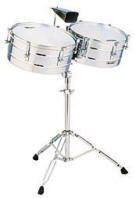| |
HISTORY

As a consequence of
Spanish colonization phenomena which was followed by Portugal,
France, Netherlands and England and due to the use of black people
brought from Africa a new social and economical context was arising
and each country was leaving behind their influences. In Cuba, one
of the most cultural places, you can find these characteristics at
the top and as years go by, a Cuban culture is shaping, but it has
its roots in Spain and Africa. Music influenced by Spanish culture
is on the farmers’ songs called guajiro and its music is called
guajira. Music influence from Africa comes from Yoruba, Bantu,
Abakua, Dahomeyanas and Caravali.
Because of this culture mixing process, the instruments used to play
this kind of music changed their morphology and function.
During the 18th century an instrumental combination in
Cuba begins and it’s called typical orchestra. It was formed by
European chords and wind instruments such as violin, clarinet,
trombone, siren, etc. And percussion instruments such as guiro and
two small cylindrical open box kettledrums called pailas. These
instruments are the latin adaptation from the kettledrum, metal
drums similar to a pot from which the kettledrums come from and are
used in classical music.
When the 19th century finished the instrumental group was
formed and it has its support on the piano, the flute and where the
kettledrums were replaced by two drums boxes fixed to a support.
This was called “French Charanga” because it was originated by the
influence of French colonization in Haiti, very close to Cuba. As
years went by and with free niggers they began to become musicians
and the kettledrum was not so far from their African drums and the
drumsticks to play were not obstacles to substitute their hands.
The kettledrum was one of the open doors used by the niggers to
introduce the rhythm coming from Africa.
Nowadays this instrument is used in jazz, rock and fusion groups
providing them new rhythmical wealth.
Methodology:
I PROVIDE PC MUSIC SOFTWARE FOR WINDOWS 64
BITS FOR RHYTHM READING WITH REAL TIMBAL SOUNDS, WHICH MAKES
LEARNING EASIER.
YOU CAN LEARN THE RHYTHMS BY LISTENING TO THEM AS THEY SOUND, YOU
CAN LEARN TO READ THEM BY MUSIC AND PLAY THEM AND YOU CAN PLAY THE
RHYTHMS AT THE SAME TIME AS THE SOFTWARE AND ALSO CHANGE THE SPEED
OF PLAYING.
Study of timbales includes:
Pailas method by Daniel Mele
Technique: Different types of sounds
Rhythmical cáscara variation
Coordinated cáscara with Son and Rumba clave
Coordination and independence of tumbados
Use of bells in combination with clave and cáscara Variations
of the
tumbados in:
mozambique, guaguanco, cumbia, afro, son montuno, bomba
Fills
baqueteo
Fussion
Polyrhythms
Supporting recorded music.
|
|

